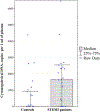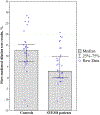Productive Cytomegalovirus Infection Is Associated With Impaired Endothelial Function in ST-Elevation Myocardial Infarction
- PMID: 31295440
- PMCID: PMC6940528
- DOI: 10.1016/j.amjmed.2019.06.021
Productive Cytomegalovirus Infection Is Associated With Impaired Endothelial Function in ST-Elevation Myocardial Infarction
Abstract
Background: An association between productive cytomegalovirus infection and atherosclerosis was shown recently in several trials, including a previous study of ours. However, the mechanism involved in this association is still under investigation. Here, we addressed the interaction between productive cytomegalovirus infection and endothelial function in patients with ST-elevation myocardial infarction (STEMI).
Methods: We analyzed the presence of cytomegaloviral DNA in plasma and endothelial function in 33 patients with STEMI and 33 volunteers without cardiovascular diseases, using real-time polymerase chain reaction (PCR) and a noninvasive test of flow-mediated dilation.
Results: Both the frequency of presence and the load of cytomegaloviral DNA were higher in plasma of patients with STEMI than those in controls. This difference was independent of other cardiovascular risk factors (7.38 [1.36-40.07]; P = 0.02). The results of the flow-mediated dilation test were lower in patients in STEMI than in controls (5.0% [2.65%-3.09%] vs 12. %5 [7.5%-15.15%]; P = 0.004) and correlated negatively with the cytomegaloviral DNA load (Spearman R = -0.407; P = 0.019) independently of other cardiovascular risk factors.
Conclusions: Productive cytomegalovirus infection in patients with STEMI correlated negatively with endothelial function independently of other cardiovascular risk factors. The impact of cytomegalovirus on endothelial function may explain the role of cytomegalovirus in cardiovascular prognosis.
Keywords: Cytomegalovirus; Endothelial function; Flow-mediated vasodilation; Polymerase chain reaction; ST-elevation myocardial infarction.
Published by Elsevier Inc.
Conflict of interest statement
Figures




Similar articles
-
[Cytomegalovirus Infection and Endothelial Function in Patients With Acute Myocardial Infarction].Kardiologiia. 2018 Jul;58(7):41-52. Kardiologiia. 2018. PMID: 30081808 Russian.
-
Red blood cells from patients with ST-elevation myocardial infarction and elevated C-reactive protein levels induce endothelial dysfunction.Am J Physiol Heart Circ Physiol. 2024 Dec 1;327(6):H1431-H1441. doi: 10.1152/ajpheart.00443.2024. Epub 2024 Oct 11. Am J Physiol Heart Circ Physiol. 2024. PMID: 39392478
-
Serial assessment of endothelial function 1, 6, and 12 months after ST-elevation myocardial infarction.Heart Vessels. 2018 Sep;33(9):978-985. doi: 10.1007/s00380-018-1145-1. Epub 2018 Mar 14. Heart Vessels. 2018. PMID: 29541845 Free PMC article. Clinical Trial.
-
Endothelial function after ST-elevation myocardial infarction in patients with high levels of high-sensitivity CRP and Lp-PLA2: A substudy of the RESPONSE randomized trial.Cardiovasc Revasc Med. 2017 Apr-May;18(3):202-206. doi: 10.1016/j.carrev.2016.12.019. Epub 2017 Jan 2. Cardiovasc Revasc Med. 2017. PMID: 28110894 Clinical Trial.
-
Incidence and predictors of left ventricular thrombus by cardiovascular magnetic resonance in acute ST-segment elevation myocardial infarction treated by primary percutaneous coronary intervention: a meta-analysis.J Cardiovasc Magn Reson. 2018 Nov 8;20(1):72. doi: 10.1186/s12968-018-0494-3. J Cardiovasc Magn Reson. 2018. PMID: 30404623 Free PMC article. Review.
Cited by
-
Novel Strategies to Combat CMV-Related Cardiovascular Disease.Pathog Immun. 2020 Sep 20;5(1):240-274. doi: 10.20411/pai.v5i1.382. eCollection 2020. Pathog Immun. 2020. PMID: 33089035 Free PMC article. Review.
-
The Role of CMV Infection in Primary Lesions, Development and Clinical Expression of Atherosclerosis.J Clin Med. 2022 Jul 1;11(13):3832. doi: 10.3390/jcm11133832. J Clin Med. 2022. PMID: 35807114 Free PMC article. Review.
-
Acute and Chronic Changes in Gene Expression After CMV DNAemia in Kidney Transplant Recipients.Front Immunol. 2021 Nov 15;12:750659. doi: 10.3389/fimmu.2021.750659. eCollection 2021. Front Immunol. 2021. PMID: 34867983 Free PMC article.
-
Infection as a Trigger for Cardiovascular Disease.Am J Med. 2020 Dec;133(12):1372-1373. doi: 10.1016/j.amjmed.2020.07.001. Epub 2020 Jul 7. Am J Med. 2020. PMID: 32649935 Free PMC article. No abstract available.
-
Cytomegalovirus and Cardiovascular Disease: A Hypothetical Role for Viral G-Protein-Coupled Receptors in Hypertension.Am J Hypertens. 2023 Aug 5;36(9):471-480. doi: 10.1093/ajh/hpad045. Am J Hypertens. 2023. PMID: 37148218 Free PMC article. Review.
References
-
- Espinola-Klein C, Rupprecht HJ, Blankenberg S, et al. Impact of infectious burden on extent and long-term prognosis of atherosclerosis. Circulation 2002;105(1):15–21. - PubMed

